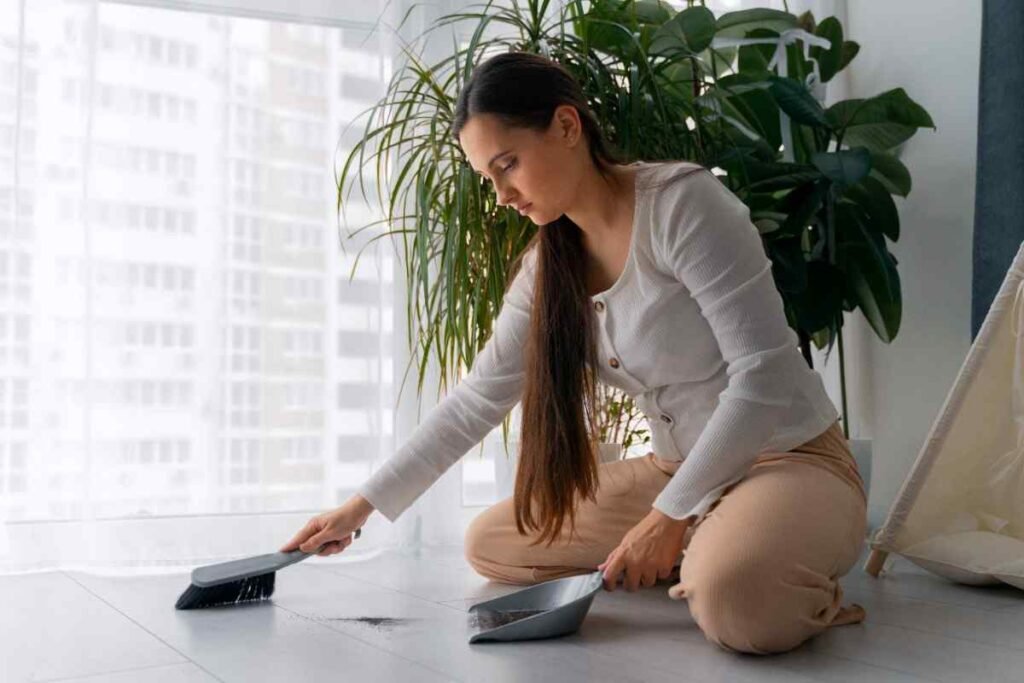Introduction
Dust—it’s the unseen, omnipresent invader that settles on surfaces, irritates allergies, and makes a clean home look less pristine. In every household, dust accumulates over time, and while it might seem like a minor inconvenience, it can significantly impact indoor air quality and overall well-being. Maintaining a dust-free home isn’t just about aesthetics; it’s essential for a healthier and more comfortable living environment. This guide delves into practical tips to reduce dust and maintain a cleaner, healthier home.

What Causes Dust?
Understanding the causes of dust is the first step in controlling it. Dust is a mixture of tiny particles, including dead skin cells, hair, pollen, mold spores, and fibers from clothing and upholstery. Several factors contribute to dust accumulation:
- Indoor Activities: Everyday activities, such as walking, cooking, and even sitting, stir up dust particles that settle on surfaces.
- Clothing and Textiles: Fibers from clothes, bedding, and upholstery contribute significantly to household dust. As these materials wear and shed fibers, they add to the dust load.
- Outdoor Pollutants: Dust can enter your home through open windows, doors, and vents. Pollen, soil, and other outdoor pollutants can be carried inside by wind or on shoes.
- HVAC Systems: Heating, ventilation, and air conditioning systems can circulate dust throughout your home if not properly maintained.
Understanding these causes helps in formulating effective strategies to minimize dust accumulation.
Why Is It Important to Reduce Dust?
Reducing dust in your home is crucial for several reasons:
- Health Benefits: Dust contains allergens that can trigger respiratory issues, such as asthma and allergies. By minimizing dust, you can reduce exposure to these irritants, leading to better respiratory health.
- Improved Air Quality: High dust levels can negatively impact indoor air quality. Cleaner air contributes to overall health and comfort.
- Longevity of Furnishings: Dust can contribute to wear and tear on furniture and electronics. Regular cleaning helps preserve the lifespan of your possessions.
- Aesthetic Appeal: A dust-free home looks and feels cleaner, enhancing overall comfort and satisfaction.
With these benefits in mind, here are essential tips to help you achieve a dust-free living environment.
Essential Home Cleaning Tips
- Regular Dusting: To effectively manage dust, establish a regular dusting routine. Use microfiber cloths or electrostatic dusters, which attract and trap dust better than traditional feather dusters. Focus on high surfaces first, like shelves and light fixtures, and then move to lower surfaces.
- Vacuum Frequently: Vacuuming is a critical step in dust control. Use a vacuum cleaner with a HEPA filter to capture fine dust particles. Be sure to vacuum carpets, rugs, and upholstery regularly. Don’t forget to vacuum under furniture and other hard-to-reach areas.
- Use Air Purifiers: Air purifiers with HEPA filters can significantly reduce dust and allergens in your home. Place them in high-traffic areas or rooms with poor ventilation to help maintain clean air.
- Change HVAC Filters: If your home has an HVAC system, changing the filters regularly is crucial. Dirty filters can spread dust and allergens throughout your home. Check and replace filters every 1-3 months, depending on use and manufacturer recommendations.
- Wash Bedding and Curtains: Fabrics like bedding and curtains attract dust and allergens. Wash bedding weekly in hot water and clean curtains or blinds every 1-2 months. Consider using washable covers on pillows and cushions.
- Maintain Clean Floors: Hard floors can also harbor dust. Sweep or vacuum them regularly and mop with a damp mop to remove any remaining dust. For added effectiveness, use a vacuum cleaner designed for hard floors.
- Keep Windows Closed: While it’s nice to let in fresh air, open windows can also let in dust and pollen. Use air conditioning or fans to maintain ventilation without introducing outdoor dust.
- Declutter Regularly: Cluttered spaces attract and trap dust. Regularly declutter and organize your home to reduce the number of surfaces where dust can accumulate. Store items in closed containers when possible.
- Clean Pet Areas: Pets shed hair and dander, which contribute to dust. Regularly groom your pets and clean their bedding to reduce the amount of pet-related dust in your home.
- Use Doormats: Place doormats at entrances to catch dirt and dust before it enters your home. Encourage family members and guests to wipe their shoes thoroughly before coming inside.
- Maintain a Humidified Environment: Dry air can cause dust to become airborne more easily. Using a humidifier to maintain optimal humidity levels (30-50%) can help reduce dust in your home.
Conclusion
Achieving a dust-free home requires a combination of regular cleaning and proactive measures. By understanding the causes of dust and implementing these essential tips, you can significantly reduce dust levels, improve indoor air quality, and create a more comfortable living environment. While completely eliminating dust may not be possible, these practices will help you stay ahead of it and maintain a healthier, cleaner home